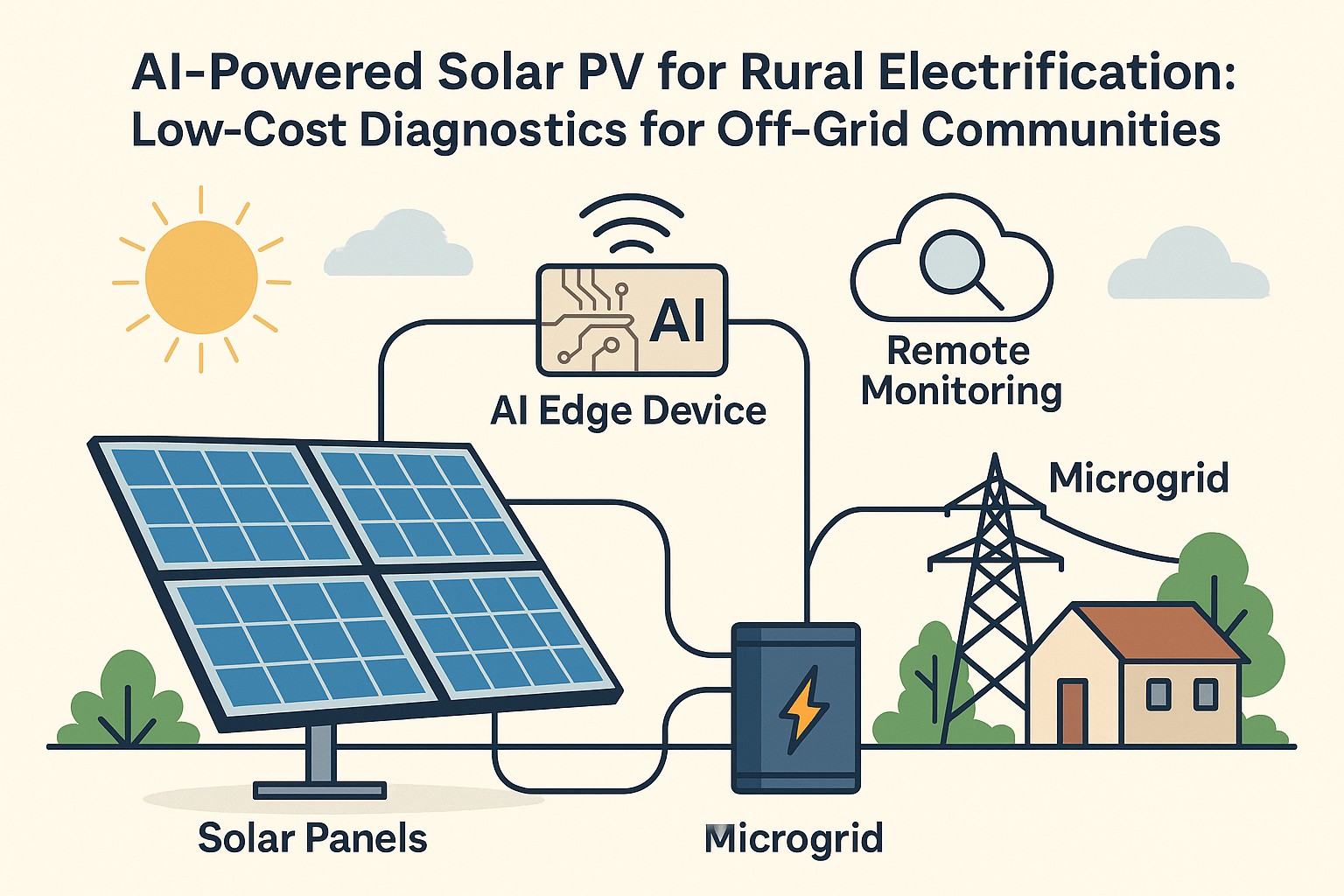
Solar PV for Rural Electrification: Low-Cost AI Solutions for Off-Grid Communities
Access to reliable electricity remains one of the defining challenges of our time. While urban centers are rapidly adopting renewable technologies, many rural and underserved communities — both in the United States and globally — still struggle with limited or unstable power supply. Solar photovoltaic (PV) technology offers a promising pathway to bridge this gap, but its long-term success depends on more than just installing panels. Effective management, predictive diagnostics, and cost-efficient maintenance are critical to ensuring that rural solar projects remain reliable and affordable. This is where artificial intelligence (AI) and edge-based monitoring come into play.
The Rural Energy Gap
According to the International Energy Agency (IEA), more than 700 million people worldwide still live without electricity. Even in developed nations like the U.S., rural areas often face unreliable grid connections, frequent blackouts, and limited investment in infrastructure. Traditional utility-scale solutions are costly and slow to deploy in sparsely populated regions.
Solar PV systems, by contrast, are modular, scalable, and relatively easy to install. Community microgrids powered by solar and storage can provide households, schools, and clinics with reliable electricity at a fraction of the cost of extending centralized transmission lines. However, these systems also bring new challenges:
- Unpredictable faults in inverters and batteries
- Difficulty in monitoring systems spread across remote locations
- High cost of sending technicians for regular maintenance
Without a smart monitoring backbone, solar projects risk falling into disrepair, undermining trust in renewable energy and slowing rural electrification.
Why AI is a Game Changer
AI-powered tools, especially when deployed on lightweight, embedded devices, are redefining the economics of rural solar electrification. Instead of relying on centralized data centers and expensive diagnostics, low-cost AI models can run directly on edge devices connected to solar inverters, batteries, or microgrid controllers.
Key capabilities include:
- Fault Prediction and Diagnostics
Algorithms like Bi-LSTM (Bidirectional Long Short-Term Memory) can learn from voltage, current, and temperature data to detect early signs of inverter or battery failure. This allows communities to repair systems before costly outages occur. - Maximum Power Point Tracking (MPPT) Optimization
Advanced control strategies, such as Extremum-Seeking Control (ESC)-based MPPT, continuously adjust PV system output under changing weather conditions, maximizing efficiency and improving return on investment. - Remote Monitoring at Scale
Cloud-enabled dashboards combined with AI anomaly detection allow technicians to monitor dozens — or even hundreds — of rural systems simultaneously, reducing the need for on-site visits. - Explainable AI for Local Training
Unlike black-box models, explainable AI frameworks can show local operators why a system is underperforming, enabling faster training and community-based maintenance.
Case Example: A Rural Cooperative in Action
Consider a rural electric cooperative managing microgrids across small farming communities. Traditionally, the cooperative would dispatch technicians monthly to inspect PV installations, often traveling hours for routine checks. With AI-powered diagnostics, the cooperative could install low-cost edge devices on each system, feeding performance data into a centralized platform.
Instead of routine visits, technicians would only be dispatched when the AI flagged anomalies — like declining inverter efficiency, irregular battery cycling, or abnormal temperature spikes. This model reduces operational costs, improves uptime, and makes solar a more sustainable solution for rural communities.
U.S. National Priorities and Rural Solar
The Department of Energy (DOE) has emphasized rural energy resilience through initiatives such as the Grid Modernization Strategy and the Energy Storage Grand Challenge. AI-enabled solar diagnostics directly support these efforts by:
- Reducing rural grid failures and improving energy equity.
- Enabling distributed, community-led energy projects aligned with U.S. decarbonization goals.
- Creating pathways for job training in AI, renewable maintenance, and grid security.
By combining low-cost solar PV with smart AI monitoring, rural electrification projects become not just sustainable but also scalable across diverse geographies.
Looking Ahead: The Roadmap for AI-Driven Rural Solar
Over the next five years, companies like GridNova Technologies are working toward scaling these solutions. The roadmap includes:
- Pilot Deployments: Demonstrating AI-based solar diagnostics in rural microgrids.
- Workforce Training: Partnering with universities and cooperatives to train technicians in AI-enabled maintenance.
- Hybrid Storage Integration: Combining solar with batteries and supercapacitors for round-the-clock power.
- Export Readiness: Adapting solutions for rural markets in South Asia, Latin America, and beyond.
Conclusion
Solar PV is already transforming the energy landscape, but its potential to empower rural communities will only be realized if systems remain reliable and affordable. AI-powered diagnostics offer the missing link — making it possible to monitor, predict, and optimize performance without the high costs of traditional maintenance models.
For millions of people, especially those in underserved or off-grid areas, this combination of low-cost solar and intelligent monitoring could mean the difference between occasional electricity and a stable, 24/7 supply of clean power. In doing so, it not only accelerates the global energy transition but also creates a more equitable and resilient energy future for all.
